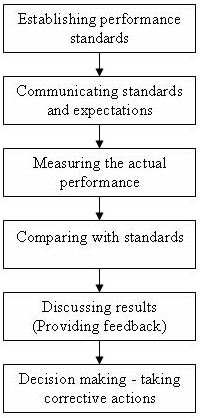Performance appraisal is the setting up of the standards which will be used to as the base to compare the actual performance of the employees. This step requires setting the criteria to judge the performance of the employees as successful or unsuccessful and the degrees of their contribution to the organizational goals and objectives. The standards set should be clear, easily understandable and in measurable terms.
Each employee is entitled to a thoughtful and careful appraisal. The success of the process depends on the supervisor’s willingness to complete a constructive and objective appraisal and on the employee’s willingness to respond to constructive suggestions and to work with the supervisor to reach future goals.
In case the performance of the employee cannot be measured, great care should be taken to describe the standards.
Communicating the Standards
Tthe responsibility of the management to communicate the standards to all the employees of the organization.
The employees should be informed and the standards should be clearly explained to the. This will help them to understand their roles and to know what exactly is expected from them. The standards should also be communicated to the appraisers or the evaluators and if required, the standards can also be modified at this stage itself according to the relevant feedback from the employees or the evaluators.

| The various rounds that comprise the appraisal cycle correspond to the different stages of the process culminating in the final grading of the employee. |
Appraise and Appraiser
The most important round is the appraisal interview itself (we will discuss more about this in a separate article) between the employee and his or her manager. The employee who is being evaluated is called the appraise and the person (usually the manager) who is doing the evaluation is called the appraiser. The appraiser and appraise prepare themselves for this round by doing a self evaluation (by the appraise) and an objective evaluation (by the appraiser). This is the round in which the most important achievements as well as glaring failures on the part of the appraise are discussed threadbare and usually the employee’s role in the process is limited to this round.
What is the outcome of the Appraisal Process
As outlined above, the outcome of the appraisal process is the grade that is decided for the employee as well as the salary hike or the bonus potential that is awarded to the employee. Typically, organizations divide the year in which the employee’s performance is evaluated into two cycles, one for deciding the salary hike and the other for deciding how much bonus he or she gets for the cycle. In this way, organizations ensure that there is no overlap in grading the employee and a fair and balanced evaluation is the desired outcome though this does not always happen in reality.
Shortcomings of the Appraisal Process
The successful completion of the appraisal process hinges on all the participants approaching the same with an intention to contribute positively instead of bringing personal biases and prejudices to the table. Management experts usually prescribe a set of do’s and don’ts to the participants in order to have an harmonious process. However, as has been pointed out above, the process itself is not without its shortcomings and the expecting the participants to be rational and objective at all times is indeed difficult. Further, since most organizations decide the grades in a way similar to the b-school equivalent of Relative Grading instead of absolute ratings, an element of competitive rivalry .
















